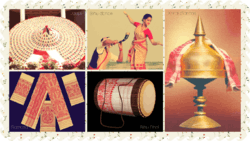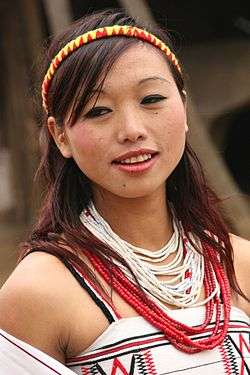Deori people
Deori is one of the major indigenous community of Assam and Arunachal Pradesh. They call themselves Jimochayan. They historically lived in the area of Sadiya, Joidaam, Patkai foothills and in the upper plains or also called as the hinterland of the Brahmaputra Valley. Concrete documented records about the history of the tribe is very limited. Scanty information was found in few books and official records. The Deori community belongs to the Sino-Tibetan family of Mongoloid stock. The community has maintained their racial traits, language, religion, folktales and traditional beliefs through the centuries.[4]
| Regions with significant populations | |
|---|---|
| Assam, Arunachal Pradesh | |
| Languages | |
| Assamese, Deori | |
| Religion | |
| Hinduism | |
| Related ethnic groups | |
| Bodo-Kachari, Assamese people, Chutiya people, Kachin, other Sino-Tibetan group |
| Part of a series on the |
| Culture of Assam |
|---|
 |
|
Proto-historic
Classical Medieval
Modern |
|
|
|
Festivals
|
|
Religion Major
Others |
|
History
Archives
Genres
Institutions Awards |
|
Music and performing arts |
|
Media |
|
Symbols
|
History
History says that the homeland of the Deoris was in the eastern regions of undivided Assam. As per the folklore of the tribe, they are settlers of the area of Joidaam and Patkai foothills and upper valley of Brahmaputra. During Burmese (Maan as called by Deoris) aggression (1817-1826) the tribe lost a lot of lives. Many slaughtered and many taken as captive. Again the destructive earthquake of 1869 devasted the whole community. The uncertainty about future prevailed amongst those who floated down in the river using bamboo and banana plant made raft. They migrated to different places alongside the rivers they floated down. As they entered and landed in their new territory, they took the name of that particular river as their clan name. Deoris under the ruler of the new land had followed the law of the land. Those Deoris who migrated to places with less interest and influence of the outside rulers had followed their culture and traditions and continued their dialect.
Some experts claim that the Patorgoyan clan assimilated with the Tiwa tribe in central Assam but there has been no scientific evidence to support the claim, which prompted a section of Deoris to begin a search. A preliminary investigation from 30 September to 5 October under the aegis of Jimachaya Giyan Aru Juktibadi Samaj has given a positive indication of the presence of Deori people in Kachin province and near Yangon in Myanmar. A team of researchers has decided to visit Myanmar in search of the lost clan.[5] Most of the people of Dibongiya class can speak their own mother tongue along with Assamese, but the rest of the 3 other classes/clans ( except few elderly persons) only understand and speak Assamese as their mother tongue. The three classes of Deoris live in the districts mentioned above.
Language
The Deori language is one of the languages of the Sino-Tibetan language family. Deori language is mainly spoken in Assam and Arunachal Pradesh. Over the years, Deori speakers, barring the Dibongia clan which uses it rigorously, have shifted to speaking the Assamese language, which can be attributed to the Language shift phenomenon.
Deori society
Deori clans
The people of Deori tribe are mainly divided into four groups or clans, namely Dibongia, Bor-geeya, Tengaponiya and Pator-goya. The entire people of each main clan or main group are again subdivided into several sub-clans or sub-groups. The word "sub-clan" or "sub-group" is called "Boja" or "Bahor" in Deori language. Some of the commonly known sub-clan are like Ariya, Kumotaya, Bihiya, Naroda, Sundhariya, Patriya, Dupiya, Marangya, Chariya, Lagasuya, Chitigaya, Mehedaya, Kuliya, Khutiya/Buruk, Machiya, Bikomiya, Phaporiya, Fagimegia, Senaboriya, Chakucharu, Ekacharul/Busaru, Simocharu, Hizaru, Popharu, Gucharu etc.[6] Each Deori people wants to know or wants to inform about their main clan and sub-clan (sub-group) in their first introduction. Otherwise, their introduction remains incomplete.
Notes
- "639 Identifier Documentation: aho – ISO 639-3". SIL International (formerly known as the Summer Institute of Linguistics). SIL International. Retrieved 29 June 2019.
Ahom [aho]
- "Population by Religious Communities". Census India – 2001. Ministry of Home Affairs, Government of India. Retrieved 1 July 2019.
Census Data Finder/C Series/Population by Religious Communities
- "Population by religion community – 2011". Census of India, 2011. The Registrar General & Census Commissioner, India. Archived from the original on 25 August 2015.
- Sharma, S.K. Discovery of Northeast India: Volume 2. Mittal Publications,2005, p. 81.
- http://www.thehindu.com/news/national/other-states/to-myanmar-in-search-of-a-lost-clan-of-the-deoris-tribe-of-assam/article6485876.ece
- http://www.deori.in/Sociallife.html
| Wikimedia Commons has media related to Deori people. |
